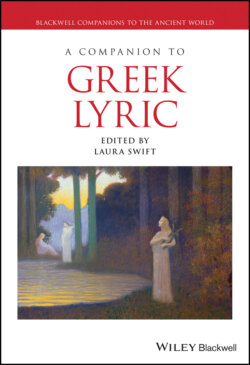Читать книгу A Companion to Greek Lyric - Группа авторов - Страница 54
Aristocratic Culture and Social Mobility
ОглавлениеIn its social aspect, the archaic and early classical symposium can be defined as a hub or focal point of the mechanisms of natural selection for the Greek aristocracy in that “ambitious non-aristocrats striving for social advancement, beyond requisite economic success allowing them to be admitted to the ranks of their local elite, had to learn, alongside their male offspring, some elements of the aristocratic culture and in particular some sympotic poetry. Once ready to join in the social élite of their community in economic terms, they would need at least some rudimentary cultural competences to be admitted” (Węcowski 2014: 76–77). In other words, investing in a family’s “cultural capital,” in the banquetal skills and sympotic poetry in the event, was a necessary prerequisite of future social advancement, so in principle all the ambitious kakoi of the highly competitive Greek communities should gravitate to a more conspicuous intimacy with aristocratic culture.
In practical terms, non-aristocratic members of Greek civic communities would have regular contact with the aristocratic symposia. At numerous festive occasions involving animal sacrifice and communal feasting, elites would customarily withdraw at some point to more specialized facilities such as hestiatoria (banqueting halls) or even impermanent huts or improvised tents—in order to ostentatiously dine and then to drink in more secluded groups all night long.20 Meanwhile, their fellow-citizens would dine and drink within the confines of the same sanctuary in the open. There were many other occasions for the kakoi to get access to the “cultural content” of the aristocratic symposia. Their familiarity with the publicly performed poetry goes without saying.21 But those interested would have had easy access at least to the widely circulating memorable utterances of sympotic poetry that must have quickly become popular.22 Those truly determined to acquire the aforementioned “cultural capital” could conceivably adopt several strategies open to them. Imitation or emulation of aristocratic symposia by non-aristocrats was always possible. But it is important to bear in mind that those groups which were capable of doing so successfully would functionally join the ranks of aristocracy as nouveaux-riches provided that they were able to deploy rudimentary elements of the said “cultural capital” and to copy those characteristics of the symposia that bestowed on their participants the status of the “leisure class.” In other words, to regularly enjoy all-night drinking but also culture-oriented parties they would need to achieve the material condition of an aristocrat anyway. A very special case of group ambitions resulting in an imitation of aristocratic symposia was identified by Kathleen Lynch in her study of the material from the Athenian Agora. Observing the sudden rise in quantity of the sympotic pottery (combined with the concomitant decline in its quality) in the final decades before the Persian Wars, Lynch concluded that aristocratic symposia must have been “democratized” in the wake of the reforms of Kleisthenes (Lynch 2011). Elaborating on this ingenious theory, I would rather interpret this phenomenon as a sign of the “aristocratization” of the new political elite who would adopt (some elements of) the aristocratic lifestyle to assert themselves as a leading group of the new regime, thus functionally becoming self-proclaimed aristocrats (Węcowski 2018). But in the socio-political realities of the archaic Greek cities, individual social advancement of successful kakoi and their families must have been by far more common. Inculcating oneself and one’s progeny in a set of specifically aristocratic cultural skills, essentially, those related to athletics and to the symposium, would be the most wide-spread strategy of social promotion among the citizens of the archaic period.
